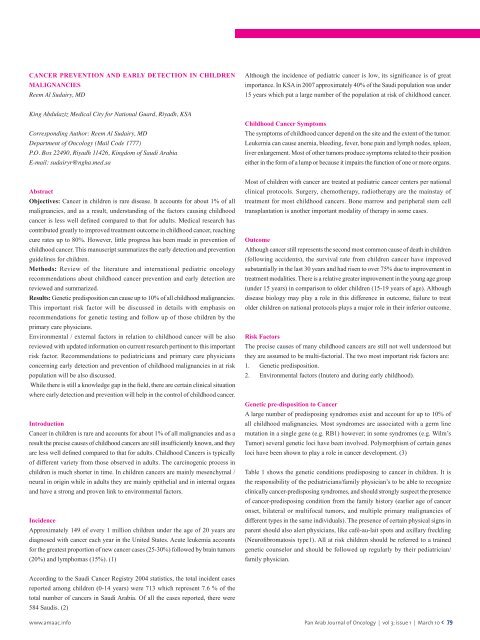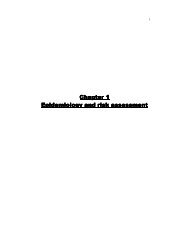Pan Arab Journal of Oncology - Arab Medical Association Against ...
Pan Arab Journal of Oncology - Arab Medical Association Against ...
Pan Arab Journal of Oncology - Arab Medical Association Against ...
Create successful ePaper yourself
Turn your PDF publications into a flip-book with our unique Google optimized e-Paper software.
CANCER PREVENTION AND EARLY DETECTION IN CHILDREN<br />
MALIGNANCIES<br />
Reem Al Sudairy, MD<br />
King Abdulaziz <strong>Medical</strong> City for National Guard, Riyadh, KSA<br />
Corresponding Author: Reem Al Sudairy, MD<br />
Department <strong>of</strong> <strong>Oncology</strong> (Mail Code 1777)<br />
P.O. Box 22490, Riyadh 11426, Kingdom <strong>of</strong> Saudi <strong>Arab</strong>ia<br />
E-mail: sudairyr@ngha.med.sa<br />
Abstract<br />
Objectives: Cancer in children is rare disease. It accounts for about 1% <strong>of</strong> all<br />
malignancies, and as a result, understanding <strong>of</strong> the factors causing childhood<br />
cancer is less well defined compared to that for adults. <strong>Medical</strong> research has<br />
contributed greatly to improved treatment outcome in childhood cancer, reaching<br />
cure rates up to 80%. However, little progress has been made in prevention <strong>of</strong><br />
childhood cancer. This manuscript summarizes the early detection and prevention<br />
guidelines for children.<br />
Methods: Review <strong>of</strong> the literature and international pediatric oncology<br />
recommendations about childhood cancer prevention and early detection are<br />
reviewed and summarized.<br />
Results: Genetic predisposition can cause up to 10% <strong>of</strong> all childhood malignancies.<br />
This important risk factor will be discussed in details with emphasis on<br />
recommendations for genetic testing and follow up <strong>of</strong> those children by the<br />
primary care physicians.<br />
Environmental / external factors in relation to childhood cancer will be also<br />
reviewed with updated information on current research pertinent to this important<br />
risk factor. Recommendations to pediatricians and primary care physicians<br />
concerning early detection and prevention <strong>of</strong> childhood malignancies in at risk<br />
population will be also discussed.<br />
While there is still a knowledge gap in the field, there are certain clinical situation<br />
where early detection and prevention will help in the control <strong>of</strong> childhood cancer.<br />
Introduction<br />
Cancer in children is rare and accounts for about 1% <strong>of</strong> all malignancies and as a<br />
result the precise causes <strong>of</strong> childhood cancers are still insufficiently known, and they<br />
are less well defined compared to that for adults. Childhood Cancers is typically<br />
<strong>of</strong> different variety from those observed in adults. The carcinogenic process in<br />
children is much shorter in time. In children cancers are mainly mesenchymal /<br />
neural in origin while in adults they are mainly epithelial and in internal organs<br />
and have a strong and proven link to environmental factors.<br />
Incidence<br />
Approximately 149 <strong>of</strong> every 1 million children under the age <strong>of</strong> 20 years are<br />
diagnosed with cancer each year in the United States. Acute leukemia accounts<br />
for the greatest proportion <strong>of</strong> new cancer cases (25-30%) followed by brain tumors<br />
(20%) and lymphomas (15%). (1)<br />
According to the Saudi Cancer Registry 2004 statistics, the total incident cases<br />
reported among children (0-14 years) were 713 which represent 7.6 % <strong>of</strong> the<br />
total number <strong>of</strong> cancers in Saudi <strong>Arab</strong>ia. Of all the cases reported, there were<br />
584 Saudis. (2)<br />
Although the incidence <strong>of</strong> pediatric cancer is low, its significance is <strong>of</strong> great<br />
importance. In KSA in 2007 approximately 40% <strong>of</strong> the Saudi population was under<br />
15 years which put a large number <strong>of</strong> the population at risk <strong>of</strong> childhood cancer.<br />
Childhood Cancer Symptoms<br />
The symptoms <strong>of</strong> childhood cancer depend on the site and the extent <strong>of</strong> the tumor.<br />
Leukemia can cause anemia, bleeding, fever, bone pain and lymph nodes, spleen,<br />
liver enlargement. Most <strong>of</strong> other tumors produce symptoms related to their position<br />
either in the form <strong>of</strong> a lump or because it impairs the function <strong>of</strong> one or more organs.<br />
Most <strong>of</strong> children with cancer are treated at pediatric cancer centers per national<br />
clinical protocols. Surgery, chemotherapy, radiotherapy are the mainstay <strong>of</strong><br />
treatment for most childhood cancers. Bone marrow and peripheral stem cell<br />
transplantation is another important modality <strong>of</strong> therapy in some cases.<br />
Outcome<br />
Although cancer still represents the second most common cause <strong>of</strong> death in children<br />
(following accidents), the survival rate from children cancer have improved<br />
substantially in the last 30 years and had risen to over 75% due to improvement in<br />
treatment modalities. There is a relative greater improvement in the young age group<br />
(under 15 years) in comparison to older children (15-19 years <strong>of</strong> age). Although<br />
disease biology may play a role in this difference in outcome, failure to treat<br />
older children on national protocols plays a major role in their inferior outcome.<br />
Risk Factors<br />
The precise causes <strong>of</strong> many childhood cancers are still not well understood but<br />
they are assumed to be multi-factorial. The two most important risk factors are:<br />
1. Genetic predisposition.<br />
2. Environmental factors (Inutero and during early childhood).<br />
Genetic pre-disposition to Cancer<br />
A large number <strong>of</strong> predisposing syndromes exist and account for up to 10% <strong>of</strong><br />
all childhood malignancies. Most syndromes are associated with a germ line<br />
mutation in a single gene (e.g. RB1) however; in some syndromes (e.g. Wilm’s<br />
Tumor) several genetic loci have been involved. Polymorphism <strong>of</strong> certain genes<br />
loci have been shown to play a role in cancer development. (3)<br />
Table 1 shows the genetic conditions predisposing to cancer in children. It is<br />
the responsibility <strong>of</strong> the pediatricians/family physician’s to be able to recognize<br />
clinically cancer-predisposing syndromes, and should strongly suspect the presence<br />
<strong>of</strong> cancer-predisposing condition from the family history (earlier age <strong>of</strong> cancer<br />
onset, bilateral or multifocal tumors, and multiple primary malignancies <strong>of</strong><br />
different types in the same individuals). The presence <strong>of</strong> certain physical signs in<br />
parent should also alert physicians, like café-au-lait spots and axillary freckling<br />
(Neur<strong>of</strong>ibromatosis type1). All at risk children should be referred to a trained<br />
genetic counselor and should be followed up regularly by their pediatrician/<br />
family physician.<br />
www.amaac.info <strong>Pan</strong> <strong>Arab</strong> <strong>Journal</strong> <strong>of</strong> <strong>Oncology</strong> | vol 3; issue 1 | March 10 < 79









